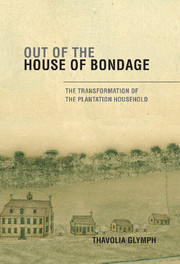Book contents
- Frontmatter
- Contents
- Acknowledgments
- Abbreviations
- Introduction
- 1 The Gender of Violence
- 2 “Beyond the Limits of Decency”
- 3 Making “Better Girls”
- 4 “Nothing but Deception in Them”
- 5 Out of the House of Bondage
- 6 “A Makeshift Kind of Life”
- 7 “Wild Notions of Right and Wrong”
- Epilogue
- Bibliography
- Index
- References
7 - “Wild Notions of Right and Wrong”
From the Plantation Household to the Wider World
Published online by Cambridge University Press: 05 June 2012
- Frontmatter
- Contents
- Acknowledgments
- Abbreviations
- Introduction
- 1 The Gender of Violence
- 2 “Beyond the Limits of Decency”
- 3 Making “Better Girls”
- 4 “Nothing but Deception in Them”
- 5 Out of the House of Bondage
- 6 “A Makeshift Kind of Life”
- 7 “Wild Notions of Right and Wrong”
- Epilogue
- Bibliography
- Index
- References
Summary
I'se Mrs. Tatom now and Hamp is Mr. Sam Ampsey Tatom.
Charity Tatom, ex-slaveThe masters disclaimed their paternal responsibilities, but they did not cease, for many decades, to complain of the “great law of insubordination,” the diminution of deference, that ensued upon the disclaimer.…
E. P. ThompsonIt often strikes me, as I think of the intense enjoyment of olden times, that perhaps just as the strongest force in physics is evolved from the greatest consumption of material, so it is ordained in human affairs that the most exquisite happiness shall be founded in the intense misery of others.
A South CarolinianVirginia Newman's first “bought dress” was a “blue guinea with yaler spots.” Two years after emancipation, Nancy Johnson counted up her possessions – one bed quilt, two calico dresses, three cotton chemises, and one basket. Jane McLeod Wilborn took the first money she earned as a free woman and bought some calico cloth and quilts. She was “proud,” she said, to have her “own quilts an' pillows an' things.” These material comforts made her home a little nicer, and, more importantly, they were hers, the small but tangible fruits of her labor as a washerwoman. Another former slave, Mollie, celebrated her freedom to put her earnings on her “back.” Decades after the end of slavery, Newman, Johnson, Wilborn, and Mollie remembered these things as concrete evidence of freedom.
- Type
- Chapter
- Information
- Out of the House of BondageThe Transformation of the Plantation Household, pp. 204 - 226Publisher: Cambridge University PressPrint publication year: 2003



